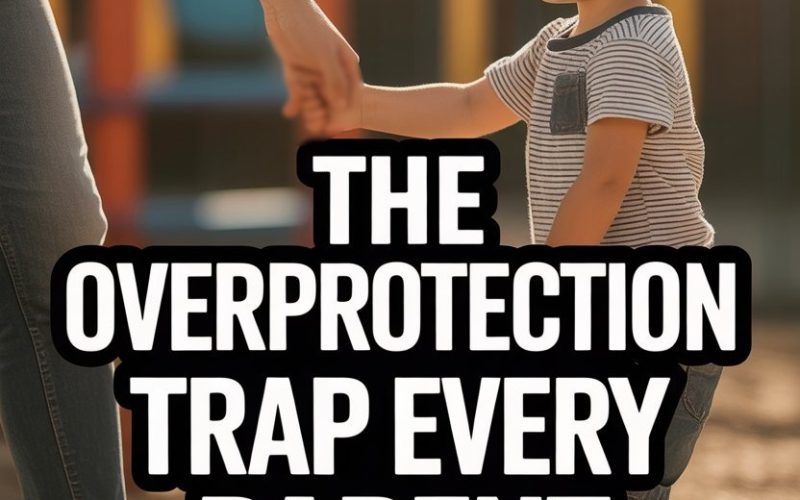Sit down for a moment—preferably somewhere you can’t hear the gentle thud of your child’s sixth attempt at acrobatics off the sofa.
Here’s the truth: every parent, no matter how seasoned or calm or “I’d never do that,” eventually finds themselves swinging on the overprotection trapeze.
It’s not a failing. It’s not even unusual. It’s just what happens when you care a little too much and the world feels a little too sharp.
But when small anxieties pile up, overprotection can quietly nudge its way into daily life.
Before you know it, you’re hovering over math assignments, triple-checking lunchbox grapes for rogue seeds, and researching bubble wrap for toddler knees.
Where’s the line between caring and coddling? And how do you give your child the freedom to grow when every instinct screams “wrap them in cotton wool!”?
Let’s untangle the knot together. Quick—before someone climbs the curtains again.
Why Overprotection Happens To The Best Of Us
Parenthood comes with an instruction manual written in invisible ink. Most of us are winging it with love, guesswork, and the occasional panicked Google search.
Overprotection often starts from a place of love—or fear. Or both.
These days, anxiety whispers are louder. Stories about playground bullying, online dangers, and food allergies fill our feeds. It’s easy to feel as if the world is a minefield.
Some research from the University of California, Irvine highlights that parents who constantly hear about risks—both real and exaggerated—are more likely to shelter their kids, even from normal age-appropriate activities.
Throw in a dash of social media comparison (“Did you see her child’s violin recital? And her matching shoes?”), plus a few cautionary tales from the school WhatsApp group, and it’s no wonder overprotection starts to look like good parenting.
What Overprotection Really Looks Like
It’s not always dramatic. There’s the classic “helicopter parent” move, but overprotection can also be subtler:
- Always stepping in during sibling squabbles, never letting them sort it themselves.
- Preempting every little discomfort, from wet socks to minor boredom.
- Doing their projects “together,” which somehow results in you gluing on the last 17 sequins.
- Organizing every minute of their day, lest a spare moment be filled with…who knows, thinking?
If you quietly nod at any of these, congratulations, you’re among friends.
The Hidden Costs Of Overprotection
Here’s where things get sticky. Overprotection feels safe in the moment, but the long-term effects can be less than ideal.
A study published in the journal Child Development found that children shielded too much from everyday challenges tend to struggle with problem-solving and lose confidence in their own abilities.
When someone always swoops in to fix things, kids start believing they can’t do it themselves—or worse, that the world is too scary to try.
Mental health can take a hit, too. Clinical psychologist Dr. Wendy Mogel warns that too much coddling can feed anxiety, not soothe it.
Kids may become frightened of failure, overly reliant on adults, or struggle with friendships because they haven’t had the chance to navigate tricky social moments on their own.
Why It’s Hard To Let Go (And Why You’re Not Alone)
Blame evolution, or maybe just the sight of tiny socks in the laundry. Letting go—just a little—goes against every protective instinct.
And here’s a zinger: today’s parents feel enormous pressure to “get it right.” If something goes wrong, it’s easy to feel at fault.
You’re not alone in thinking, “If I don’t step in, will she get hurt? If I do, will she never learn?” The parenting tightrope has never been wobblier.
Building Resilience One Scraped Knee At A Time
Resilience is a word tossed around like confetti at a birthday party, but what does it actually mean for children? It starts with small opportunities to try, fail, and try again—without a safety net made entirely of grown-ups.
Child development expert Dr. Angela Duckworth, known for her work on grit, suggests that kids need “desirable difficulties.”
These are challenges just tough enough to help them stretch, but not so hard they give up in frustration.
Sometimes, this means biting your tongue while your child negotiates a playground dispute, or letting them walk (gasp) to the shop with a friend.
The trick is not to throw them to the wolves, but to step back just enough. Kids who feel trusted are more likely to trust themselves.
Practical Ways To Step Back Tonight
Feeling twitchy about cutting the apron strings? Here are some easy changes that won’t leave you wide awake at 2am:
- If your child asks for help, ask what they’ve already tried.
- Next time they’re bored, resist the urge to “fix it.” Boredom breeds creativity (and sometimes questionable puppet theatre).
- Encourage them to solve conflicts with siblings or friends before you mediate.
- Allow manageable risks: climbing the slide, helping chop veg (with supervision, unless you fancy a trip to A&E), or choosing their own clothes—even if they pair stripes with polka dots.
Small risks, small rewards. But little by little, you’ll see them grow.
How To Talk About Risk Without Raising Fear
Risk isn’t a four-letter word. Kids need to know what’s dangerous and what’s just challenging. Have open conversations about what feels scary, what feels exciting, and which rules exist for their safety.
Model calm concern instead of panic. Instead of “Don’t you dare climb that tree!” try “What’s your plan if you get stuck?” You’re teaching problem-solving, not just caution.
And when your nerves jangle? Deep breaths, maybe a quiet cuppa, and the knowledge that you’re teaching life skills, not just survival skills.
When To Step In (And When To Chill Out)
The line isn’t always clear. Physical safety matters. Emotional safety matters too.
Children need to know you’re there, even when you’re not hovering.
A simple rule of thumb: ask yourself, “Is this situation dangerous, or just uncomfortable for them (or me)?” If it’s the latter, odds are it’s a good chance for growth.
Sometimes, kids genuinely need backup—bullying, serious injuries, or when they’re in over their heads. Trust your gut. But notice whether you’re stepping in for their sake, or to soothe your own worry.
Dealing With The Guilt And The What Ifs
Guilt visits every parent sooner or later. Did you let them fall too hard? Did you not let them fall enough?
Psychologist Dr. Lisa Damour says guilt is a sign that you care. It only becomes a problem when it turns into a steering wheel instead of a rearview mirror.
Talk it out with a trusted friend or your partner. Remind yourself that perfect parenting doesn’t exist. Progress, not perfection—just like the state of your living room most days.
Encouraging Independence, One Small Step At A Time
It’s tempting to go from “doing everything” to “do it yourself” overnight. Children, though, need scaffolding—gradual support while they practice new skills.
Try breaking big tasks into smaller steps. Cooking dinner together? Let them chop the carrots before they tackle the whole stew.
Heading to a birthday party? Let them choose the gift, wrap it (yes, even if there’s more tape on the outside than in the box), and hand it over themselves.
Praise effort, not just success. Celebrate risk-taking, even when it doesn’t work out. You’ll see their confidence unfurl bit by bit.
Raising Confident Kids, Not Cautious Adults
The goal isn’t to raise children who are fearless, but ones who are brave enough to try. Even the most independent kids need a soft place to land.
Your job is to make sure the net is there—but not so tight they never jump.
Independence looks different for every child. Some will sprint ahead into the unknown, while others need a gentle nudge.
Either way, giving them space sends a powerful message: “I believe you can handle this—even if you mess up.”
The Sweet Spot: Loving, Not Smothering
All this talk of letting go might sound a bit cold, but that’s not the endgame. Children blossom with love, encouragement, and the freedom to make their own mistakes (and triumphs).
Boundaries matter. So does the unconditional hug after a hard day.
If you’re worried you’re “doing it wrong,” congratulations: that worry means you care. And if you’re reading this while your child elbows you for the iPad, maybe you care a bit extra.
Finding Your Balance
Every parent stumbles into the overprotection trap now and then. It’s a sign you love hard—and maybe you hate seeing your child hurt, fail, or, heaven forbid, get bored on a rainy day.
But every step back you take gives your child a step forward.
And isn’t that what we’re all after in the end—kids who are not just safe, but strong enough to face the world, wobbly bits and all?
Now, off you go. There’s a sofa to leap from and a child who might just surprise you.





